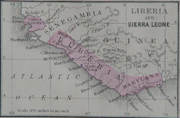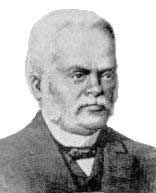|
Anthony William Gardiner (1820-1885)
was born in Virginia, U.S.A. He came with his parents to Liberia where
they arrived in January 1831. Little is known of his childhood years in
Southampton, Virginia, or in the Liberia Colony of the American
Colonization Society that had paid for his trip to Africa aboard the
brig Volador. The Gardiner family settled in Grand Bassa County where
the young Anthony Gardiner upon completion of his law studies started
his public career.
In 1847 he participated as delegate to the National Convention from
Grand Bassa County in the declaration of Independence and the
preparation of the Constitution of the new republic. He served in the
Administration of President Roberts (1848-55) as Attorney-General and
between 1855 and 1871 in the National Legislature, representing Grand
Bassa County.
After President Roye’s forcible removal from office,
Anthony Gardiner became Vice-President under J.J. Roberts with whom he
served two two-year terms (until 1876). When President Roberts became
very ill and left for England for medical treatment, in June 1875,
Vice-President Gardiner was appointed ‘Acting President’. One month
earlier, James Spriggs Payne had won the presidential elections. Payne
was installed as President of Liberia in January 1876, but the following
year Gardiner successfully ran for the Presidency on the True Whig Party
ticket. He thus became the third President of Liberia who was born in
Virginia, USA, after J.J. Roberts and James Spriggs Payne.
President Gardiner was inaugurated in January 1878. He was elected two
more times, but did not finish his third presidential term. On January
20, 1883 President Gardiner resigned, upset and disappointed, the last
victim of the Northwest Boundary Question that had been under discussion
since 1860. This decision made Anthony W. Gardiner the first president
of Liberia who voluntarily resigned.
Important parts of the history of Liberia are untold. Anthony W.
Gardiner’s presidency is one of them. As President he was the only
survivor of the eleven colonists who in 1847 had signed the Declaration
of Independence. In his Inaugural Adressses he pleaded for more Ports of
Entry for purposes of trade, more liberal laws for the admission of
foreign capital for investment purposes, the incorporation of the native
tribes in Liberian politics and society and the promotion of public
education. Very significantly (see below), one of President Gardiner’s
most important decisions was the creation of an Interior Department in
1880. A well-known West-Indian born immigrant,
Edward Wilmot Blyden,
became the first Interior Secretary.
|
|
 |
|
(click to supersize) |
|
The Scramble for Africa
It was during the Administration of President Gardiner that Liberia’s territorial expansion was at its zenith with a sea coast of about 600 miles stretching from the
Gallinas territory in the west (now part of Sierra Leone) to the San Pedro river in the east (in modern Cote d’Ivoire) and including a vast hinterland. The inland area claimed by the Government in Monrovia reached as far as Musadu and Boporo, in nowadays Guinea. In the late 1860s and early 1870s this region had been visited by an expedition despatched by the Liberian Government under command of Benjamin J.K. Anderson who laid the foundation for this claim by concluding treaties with local chiefs. Liberia’s territorial claims, however, were not undisputed. European powers - Great Britain, France and Germany – but also native tribes contested Liberian souvereignty.
When in 1875 Gardiner took over from J.J. Roberts as Acting President he was confronted with a serious Grebo uprising in Maryland County which the government quelled after a costly military expedition. Also the Kru in the eastern part of the country were not under control. But the most pressing problem was in the extreme western part of the country. As from 1860 the British Government increasingly put pressure upon the Liberian Government to cede the
Gallinas territory. The late 1870s and early 1880s were the years of growing European imperialism in Africa, a historical process highlighted by the 1884-85
Berlin
Conference. In 1883, on the eve of the international conference that would have a lasting impact on the history of Africa, President Anthony Gardiner became the victim of the
Scramble for Africa – as the carving up of the continent by five European powers is commonly known - that only left Liberia and Ethiopia unconquered though not unaffected.
The dispute over the Gallinas territory
The Gallinas or Galinhas territory lies between the Sherbro river, in nowadays Sierra Leone, and the Mano or Mannah river which actually forms the border between Liberia and Sierra Leone. In the early 1800s slave traders yearly shipped thousands of slaves from this area for their single journey across the Atlantic
Ocean. One of the most notorious slavers was
Theophilus Conneau (or Theodore Canot, see bibliography). In 1839 the schooner
Amistad sailed from this region, the revolt of the captured and enslaved Africans it carried became known all over the world after being
filmed.
The territorial dispute over the Gallinas between the Liberian and British Governments
already dated from the time of the first President of Liberia J.J.
Roberts. Subsequently, in 1869, during the Administration of President James Spriggs Paynes, British gun-boats
arrived in Monrovia to settle the dispute. Liberia became increasingly subjected to British pressure as a result of the Northwest Boundary Question which harrassed President Gardiner throughout his term of office. In 1875 the question was temporarily shelved after a US navy ship had visited Monrovia. But in 1880 Sir Arthur Havelock became Governor of Sierra Leone and he was finally successful in establishing British authority over the disputed territory between the Sherbro and Mano rivers.
In March 1882 Sir Havelock came to Monrovia, accompanied by four gun-boats, demanding the immediate recognition of British authority over the disputed area. He also demanded an indemnity of $ 40,000 for losses British traders in the region had sustained following attacks by rebellious Vai in 1871. President Gardiner appointed Edward Blyden, the Interior Secretary, as main negotiator with Sir Havelock. Edward Blyden already had been involved in the 1860s in the settlement of the dispute, then as Secretary of State. He soon reached agreement with the British Governor and signed a treaty with him, the Havelock-Blyden Treaty. Havelock returned to Sierra Leone after the apparent success of his gun-boat diplomacy but the Liberian Senate rejected the treaty. The opposition was led by Vice-President Alfred Russel who accused President Gardiner and Edward Blyden of having giving Liberian territory away to the British. In September 1882 Governor Havelock returned with his gun-boats.
President Gardiner questioned Havelock’s claims. If the contested territory was British, why should Liberia pay an indemnity for failing to protect British traders? If, however, the Liberian Government would reckognize its responsibility and pay the indemnity, why should it cede the territory? But Governor Havelock demanded ratification of the treaty. Disappointed by the lack of internal support for his handling of the boundary dispute and in protest against the overt demonstration of British imperialism, President Gardiner resigned on January 20,
1983. He was succeeded by
Vice-President Alfred
Russell. Two months later, in March 1883, the British Government annexed the territory west of the Mano river.
In 1885 the then President of Liberia, Hilary Johnson, agreed to the annexation after the US Government had advised him to yield to the British demands. Subsequently, in November of that year the Havelock Draft Convention was ratified by both Liberia and Great Britain. Henceforth, the Mano river forms the boundary between Liberia and Sierra Leone. It had cost Liberia approximately $ 100,000 to obtain and defend the territory it thus lost. Eventually, in 1903 when the Anglo-Liberian Boundary Treaty precisely defined the boundary areas of Liberia and Sierra Leone, it was agreed that Liberia would receive 4,750 British Pounds as indemnities for the loss of this territory.
|
|
|
Sources and recommended literature:
Anderson, Benjamin, 'Journeys to Musadu', Narrative of a Journey to Musardu the capital of the Western Mandingoes Together with Narrative of the expedition despatched to Musahdu by the Liberian Government under Benjamin J.K. Anderson in 1874 (London, 1971; first edition 1870 respectively 1912).
Banks, A. Doris - Henries, ‘Presidents of the First African Republic’ (London, 1963).
Guannu, Joseph Saye, ‘Liberian History Since 1857’ (Monrovia, 1980).
Guannu, Joseph Saye (ed.) Inaugural Addresses of the Presidents of Liberia – From Joseph Jenkins Roberts to William Richard Tolbert, Jr, 1848 to 1976’ (New York, 1980).
Holsoe,
Svend E., ‘Theodore Canot at Cape Mount, 1841-1847’, in: The
Liberian Studies Journal, Vol. IV, number 2, 1971-1972, pp.163-183
(Newark, 1973).
Jones, Adam, ‘A History of the Gallinas
Country, Sierra Leone, c. 1650-1890’, Ph.D. thesis (Birmingham, 1979).
Jones,
Adam, ‘ From Slaves to Palm Kernels: A History of the
Gallinas Country, West Africa’ (Wiesbaden, 1983).
Karnga, Abayomi, ‘History of Liberia’ (Liverpool, 1926).
Kraaij, van der, Fred, ‘The Open Door Policy of Liberia - An Economic History of Modern Liberia’, 2 volumes, 703 pp. (Bremen, 1983).
Lynch, Hollis R., ‘Edward Wilmot Blyden, Pan-Negro Patriot 1832-1912’ (Oxford, 1967).
Richardson, Nathaniel R., ‘Liberia’s Past and Present’ (London, 1959).
Wauwermans, Henri, E. ‘Libéria – histoire de la fondation d’un état nègre libre’ (Bruxelles, 1885).
|
|

